height adjustment Seat Toledo 2012 Owner's manual
[x] Cancel search | Manufacturer: SEAT, Model Year: 2012, Model line: Toledo, Model: Seat Toledo 2012Pages: 249, PDF Size: 3.6 MB
Page 8 of 249
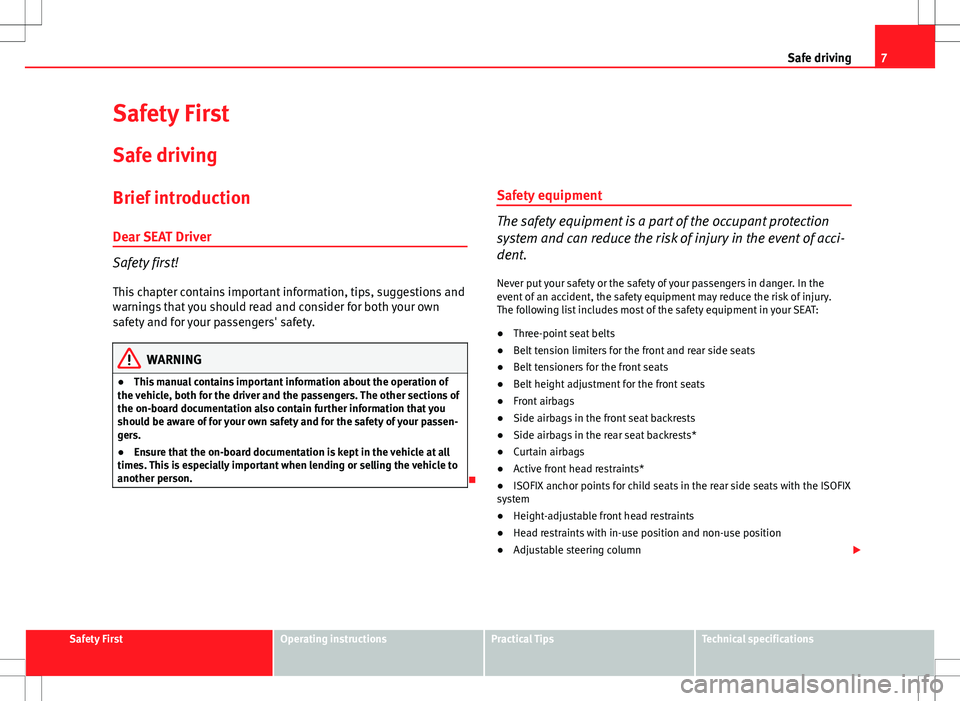
7
Safe driving
Safety First
Safe driving
Brief introduction
Dear SEAT Driver
Safety first! This chapter contains important information, tips, suggestions and
warnings that you should read and consider for both your own
safety and for your passengers' safety.
WARNING
● This manual contains important information about the operation of
the vehicle, both for the driver and the passengers. The other sections of
the on-board documentation also contain further information that you
should be aware of for your own safety and for the safety of your passen-
gers.
● Ensure that the on-board documentation is kept in the vehicle at all
times. This is especially important when lending or selling the vehicle to
another person.
Safety equipment
The safety equipment is a part of the occupant protection
system and can reduce the risk of injury in the event of acci-
dent.
Never put your safety or the safety of your passengers in danger. In the
event of an accident, the safety equipment may reduce the risk of injury.
The following list includes most of the safety equipment in your SEAT:
● Three-point seat belts
● Belt tension limiters for the front and rear side seats
● Belt tensioners for the front seats
● Belt height adjustment for the front seats
● Front airbags
● Side airbags in the front seat backrests
● Side airbags in the rear seat backrests*
● Curtain airbags
● Active front head restraints*
● ISOFIX anchor points for child seats in the rear side seats with the ISOFIX
system
● Height-adjustable front head restraints
● Head restraints with in-use position and non-use position
● Adjustable steering column
Safety FirstOperating instructionsPractical TipsTechnical specifications
Page 15 of 249
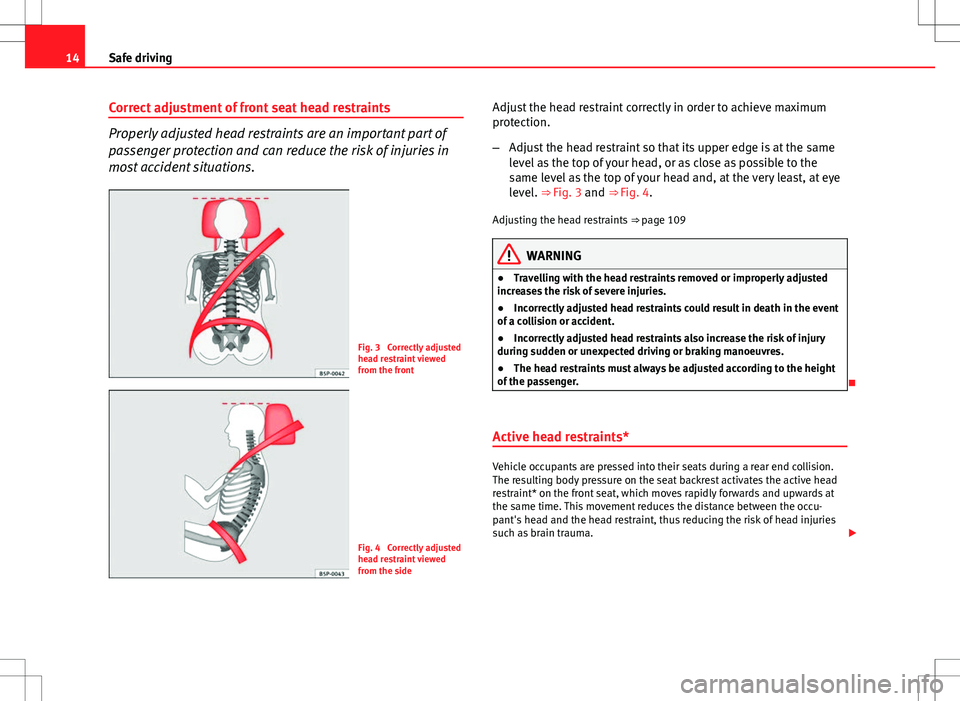
14Safe driving
Correct adjustment of front seat head restraints
Properly adjusted head restraints are an important part of
passenger protection and can reduce the risk of injuries in
most accident situations.
Fig. 3 Correctly adjusted
head restraint viewed
from the front
Fig. 4 Correctly adjusted
head restraint viewed
from the side Adjust the head restraint correctly in order to achieve maximum
protection.
–
Adjust the head restraint so that its upper edge is at the same
level as the top of your head, or as close as possible to the
same level as the top of your head and, at the very least, at eye
level. ⇒ Fig. 3 and ⇒ Fig. 4.
Adjusting the head restraints ⇒ page 109
WARNING
● Travelling with the head restraints removed or improperly adjusted
increases the risk of severe injuries.
● Incorrectly adjusted head restraints could result in death in the event
of a collision or accident.
● Incorrectly adjusted head restraints also increase the risk of injury
during sudden or unexpected driving or braking manoeuvres.
● The head restraints must always be adjusted according to the height
of the passenger.
Active head restraints*
Vehicle occupants are pressed into their seats during a rear end collision.
The resulting body pressure on the seat backrest activates the active head
restraint* on the front seat, which moves rapidly forwards and upwards at
the same time. This movement reduces the distance between the occu-
pant's head and the head restraint, thus reducing the risk of head injuries
such as brain trauma.
Page 16 of 249

15
Safe driving
WARNING
Travelling with the head restraints removed or improperly adjusted in-
creases the risk of severe injuries.
● Incorrectly adjusted head restraints could result in death in the event
of a collision or accident.
● Incorrectly adjusted head restraints also increase the risk of injury
during sudden or unexpected driving or braking manoeuvres.
● The head restraints must always be adjusted according to the height
of the passenger.
Note
The active head restraints* could also be triggered if a vehicle occupant ap-
plies a high level of pressure to the seat backrest (e.g. by “falling” back into
the seat when entering the vehicle) or if pressure is applied to a front seat
head restraint from the rear. This accidental activation is, however, not dan-
gerous, as the active head restraints will return to the original position im-
mediately and are thus once again ready. Correct adjustment of rear seat head restraints
Properly adjusted head restraints are an important part of
the passenger protection and can reduce the risk of injuries
in most accident situations
Fig. 5 Head restraints in
correct position
Rear outer seat head restraints
– The rear outer seat head restraints have 4 positions.
– Three positions for use ⇒ Fig. 5 . In these positions, the head
restraints are used normally, protecting passengers along with
the rear seat belts.
– And one position for non-use.
– To fit the head restraints in position for use, pull on the edges
with both hands in the direction of the arrow.
Centre rear head restraint
– The centre head restraint only has two positions, in-use (head
restraint up) and non-use (head restraint down).
Safety FirstOperating instructionsPractical TipsTechnical specifications
Page 28 of 249

27
Seat belts
Seat belt position
Seat belts offer their maximum protection only when they
are properly positioned.
Fig. 12 Correct seat belt
and head restraint posi-
tions, viewed from front
Fig. 13 Correct seat belt
and head restraint posi-
tions, viewed from side The following features are available to adjust the seat belt in the shoulder
region:
●
belt height adjustment for the front seats.
● front seat height adjustment*.
WARNING
● An incorrectly worn seat belt can cause severe injuries in the event of
an accident.
● The shoulder part of the seat belt must lie on the centre of the shoul-
der, never across the neck. The seat belt must lie flat and snugly on the
torso ⇒ Fig. 12.
● The lap part of the seat belt must lie across the pelvis, never across
the stomach. The seat belt must lie flat and snugly on the pelvis
⇒ Fig. 13. Pull the belt tight if necessary to take up any slack.
● Read and observe the warnings ⇒ page 24.
Safety FirstOperating instructionsPractical TipsTechnical specifications
Page 47 of 249

46Child safety
WARNING
● Never install a child seat facing backwards on the front passenger
seat unless the front passenger front airbag has been disabled. This
could lead to a risk of potentially fatal injuries to the child! However, if it
is necessary, in exceptional cases, to transport a child in the front pas-
senger seat, the front passenger front airbag must always be disabled
⇒ page 43. If the passenger seat has a height adjustment option, move it
to the highest position.
● For those vehicles that do not include a key lock switch to disable the
airbag, the vehicle must be taken to a Technical Service.
● All vehicle occupants, especially children, must assume the proper
sitting position and be properly belted in while travelling.
● Never hold children or babies on your lap, this can result in potential-
ly fatal injuries to the child!
● Never allow a child to be transported in a vehicle without being prop-
erly secured, or to stand up or kneel on a seat while travelling. In an acci-
dent, the child could be thrown through the vehicle, causing possibly fa-
tal injuries to themselves and to the other vehicle occupants.
● If children assume an improper sitting position when the vehicle is
moving, they expose themselves to greater risk of injury in the event of a
sudden braking manoeuvre or in an accident. This is particularly impor-
tant if the child is travelling on the front passenger seat and the airbag
system is triggered in an accident; as this could cause serious injury or
even death.
● A suitable child seat can protect your child.
● Never leave an unsupervised child alone on a child seat or in the vehi-
cle.
● Depending on weather conditions, it may become extremely hot or
cold inside the vehicle. This can be fatal.WARNING (Continued)
● Children who are less than 1.5 metres tall must not wear a normal
seat belt without a child seat, as this could cause injuries to the abdomi-
nal and neck areas during a sudden braking manoeuvre or in an accident.
● Do not allow the seat belt to become twisted or jammed, or to rub on
any sharp edges.
● Incorrectly worn seat belts can cause injuries even in a minor colli-
sion or in sudden braking manoeuvres.
● The seat belt provides maximum protection only when the seat belt is
properly positioned ⇒ page 26, Seat belts.
● Only one child may occupy a child seat ⇒ page 47, Child seats.
Page 109 of 249
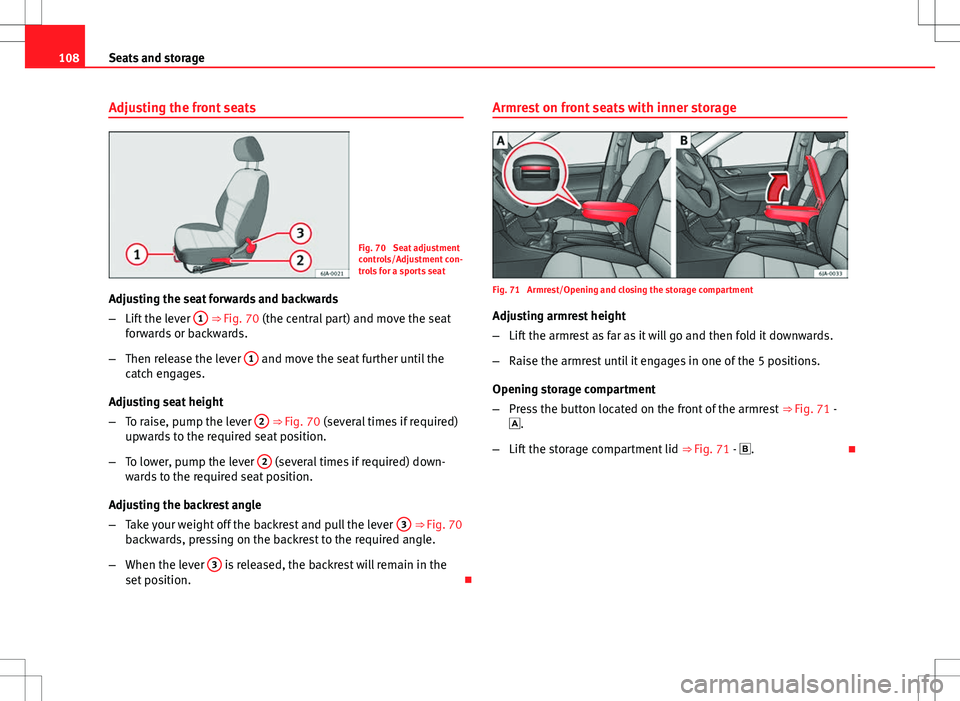
108Seats and storage
Adjusting the front seats
Fig. 70 Seat adjustment
controls/Adjustment con-
trols for a sports seat
Adjusting the seat forwards and backwards
– Lift the lever 1
⇒ Fig. 70 (the central part) and move the seat
forwards or backwards.
– Then release the lever 1
and move the seat further until the
catch engages.
Adjusting seat height
– To raise, pump the lever 2
⇒ Fig. 70 (several times if required)
upwards to the required seat position.
– To lower, pump the lever 2
(several times if required) down-
wards to the required seat position.
Adjusting the backrest angle
– Take your weight off the backrest and pull the lever 3
⇒ Fig. 70
backwards, pressing on the backrest to the required angle.
– When the lever 3
is released, the backrest will remain in the
set position. Armrest on front seats with inner storage
Fig. 71 Armrest/Opening and closing the storage compartment
Adjusting armrest height
– Lift the armrest as far as it will go and then fold it downwards.
– Raise the armrest until it engages in one of the 5 positions.
Opening storage compartment
– Press the button located on the front of the armrest ⇒ Fig. 71 -
.
– Lift the storage compartment lid ⇒ Fig. 71 - .
Page 111 of 249
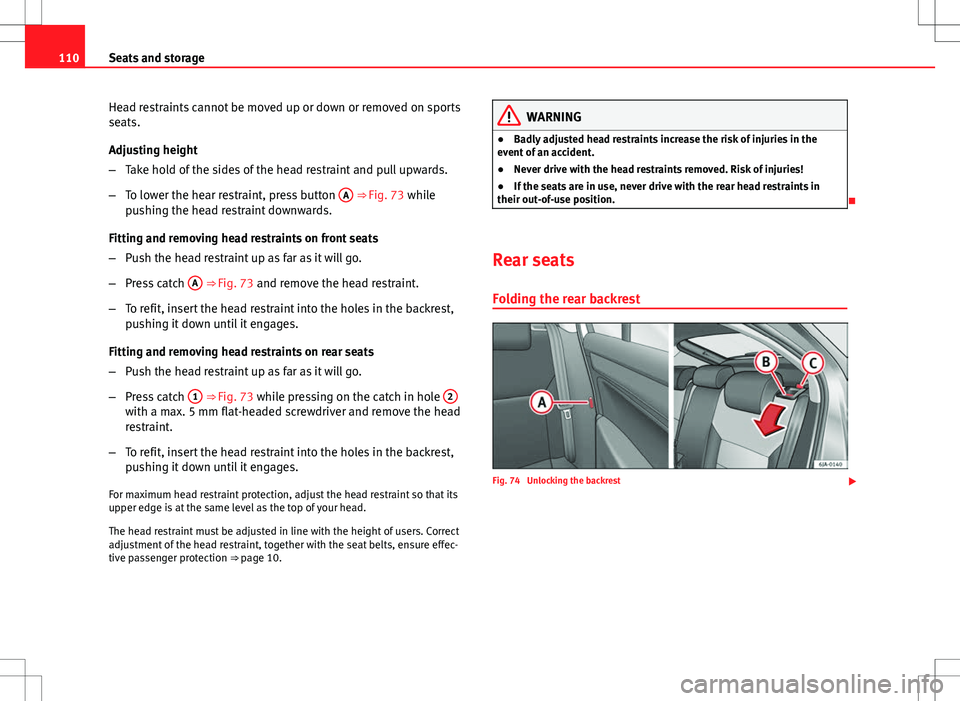
110Seats and storage
Head restraints cannot be moved up or down or removed on sports
seats.
Adjusting height
–Take hold of the sides of the head restraint and pull upwards.
– To lower the hear restraint, press button A
⇒ Fig. 73 while
pushing the head restraint downwards.
Fitting and removing head restraints on front seats
– Push the head restraint up as far as it will go.
– Press catch A
⇒ Fig. 73 and remove the head restraint.
– To refit, insert the head restraint into the holes in the backrest,
pushing it down until it engages.
Fitting and removing head restraints on rear seats
– Push the head restraint up as far as it will go.
– Press catch 1
⇒ Fig. 73 while pressing on the catch in hole 2with a max. 5 mm flat-headed screwdriver and remove the head
restraint.
– To refit, insert the head restraint into the holes in the backrest,
pushing it down until it engages.
For maximum head restraint protection, adjust the head restraint so that its
upper edge is at the same level as the top of your head.
The head restraint must be adjusted in line with the height of users. Correct
adjustment of the head restraint, together with the seat belts, ensure effec-
tive passenger protection ⇒ page 10.
WARNING
● Badly adjusted head restraints increase the risk of injuries in the
event of an accident.
● Never drive with the head restraints removed. Risk of injuries!
● If the seats are in use, never drive with the rear head restraints in
their out-of-use position.
Rear seats
Folding the rear backrest
Fig. 74 Unlocking the backrest
Page 240 of 249
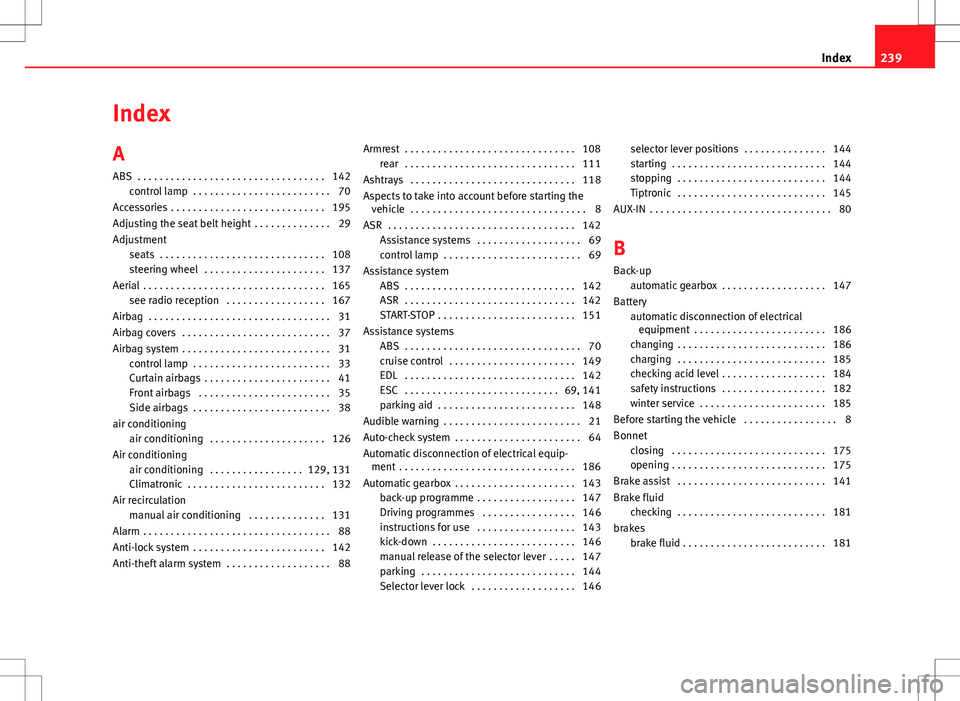
Index
A
ABS . . . . . . . . . . . . . . . . . . . . . . . . . . . . . . . . . . 142control lamp . . . . . . . . . . . . . . . . . . . . . . . . . 70
Accessories . . . . . . . . . . . . . . . . . . . . . . . . . . . . 195
Adjusting the seat belt height . . . . . . . . . . . . . . 29
Adjustment seats . . . . . . . . . . . . . . . . . . . . . . . . . . . . . . 108
steering wheel . . . . . . . . . . . . . . . . . . . . . . 137
Aerial . . . . . . . . . . . . . . . . . . . . . . . . . . . . . . . . . 165 see radio reception . . . . . . . . . . . . . . . . . . 167
Airbag . . . . . . . . . . . . . . . . . . . . . . . . . . . . . . . . . 31
Airbag covers . . . . . . . . . . . . . . . . . . . . . . . . . . . 37
Airbag system . . . . . . . . . . . . . . . . . . . . . . . . . . . 31 control lamp . . . . . . . . . . . . . . . . . . . . . . . . . 33
Curtain airbags . . . . . . . . . . . . . . . . . . . . . . . 41
Front airbags . . . . . . . . . . . . . . . . . . . . . . . . 35
Side airbags . . . . . . . . . . . . . . . . . . . . . . . . . 38
air conditioning air conditioning . . . . . . . . . . . . . . . . . . . . . 126
Air conditioning air conditioning . . . . . . . . . . . . . . . . . 129, 131
Climatronic . . . . . . . . . . . . . . . . . . . . . . . . . 132
Air recirculation manual air conditioning . . . . . . . . . . . . . . 131
Alarm . . . . . . . . . . . . . . . . . . . . . . . . . . . . . . . . . . 88
Anti-lock system . . . . . . . . . . . . . . . . . . . . . . . . 142
Anti-theft alarm system . . . . . . . . . . . . . . . . . . . 88 Armrest . . . . . . . . . . . . . . . . . . . . . . . . . . . . . . . 108
rear . . . . . . . . . . . . . . . . . . . . . . . . . . . . . . . 111
Ashtrays . . . . . . . . . . . . . . . . . . . . . . . . . . . . . . 118
Aspects to take into account before starting the vehicle . . . . . . . . . . . . . . . . . . . . . . . . . . . . . . . . 8
ASR . . . . . . . . . . . . . . . . . . . . . . . . . . . . . . . . . . 142 Assistance systems . . . . . . . . . . . . . . . . . . . 69
control lamp . . . . . . . . . . . . . . . . . . . . . . . . . 69
Assistance system ABS . . . . . . . . . . . . . . . . . . . . . . . . . . . . . . . 142
ASR . . . . . . . . . . . . . . . . . . . . . . . . . . . . . . . 142
START-STOP . . . . . . . . . . . . . . . . . . . . . . . . . 151
Assistance systems ABS . . . . . . . . . . . . . . . . . . . . . . . . . . . . . . . . 70
cruise control . . . . . . . . . . . . . . . . . . . . . . . 149
EDL . . . . . . . . . . . . . . . . . . . . . . . . . . . . . . . 142
ESC . . . . . . . . . . . . . . . . . . . . . . . . . . . . 69, 141
parking aid . . . . . . . . . . . . . . . . . . . . . . . . . 148
Audible warning . . . . . . . . . . . . . . . . . . . . . . . . . 21
Auto-check system . . . . . . . . . . . . . . . . . . . . . . . 64
Automatic disconnection of electrical equip- ment . . . . . . . . . . . . . . . . . . . . . . . . . . . . . . . . 186
Automatic gearbox . . . . . . . . . . . . . . . . . . . . . . 143 back-up programme . . . . . . . . . . . . . . . . . . 147
Driving programmes . . . . . . . . . . . . . . . . . 146
instructions for use . . . . . . . . . . . . . . . . . . 143
kick-down . . . . . . . . . . . . . . . . . . . . . . . . . . 146
manual release of the selector lever . . . . . 147
parking . . . . . . . . . . . . . . . . . . . . . . . . . . . . 144
Selector lever lock . . . . . . . . . . . . . . . . . . . 146 selector lever positions . . . . . . . . . . . . . . . 144
starting . . . . . . . . . . . . . . . . . . . . . . . . . . . . 144
stopping . . . . . . . . . . . . . . . . . . . . . . . . . . . 144
Tiptronic . . . . . . . . . . . . . . . . . . . . . . . . . . . 145
AUX-IN . . . . . . . . . . . . . . . . . . . . . . . . . . . . . . . . . 80
B
Back-up automatic gearbox . . . . . . . . . . . . . . . . . . . 147
Battery automatic disconnection of electricalequipment . . . . . . . . . . . . . . . . . . . . . . . . 186
changing . . . . . . . . . . . . . . . . . . . . . . . . . . . 186
charging . . . . . . . . . . . . . . . . . . . . . . . . . . . 185
checking acid level . . . . . . . . . . . . . . . . . . . 184
safety instructions . . . . . . . . . . . . . . . . . . . 182
winter service . . . . . . . . . . . . . . . . . . . . . . . 185
Before starting the vehicle . . . . . . . . . . . . . . . . . 8
Bonnet closing . . . . . . . . . . . . . . . . . . . . . . . . . . . . 175
opening . . . . . . . . . . . . . . . . . . . . . . . . . . . . 175
Brake assist . . . . . . . . . . . . . . . . . . . . . . . . . . . 141
Brake fluid checking . . . . . . . . . . . . . . . . . . . . . . . . . . . 181
brakes brake fluid . . . . . . . . . . . . . . . . . . . . . . . . . . 181
239
Index